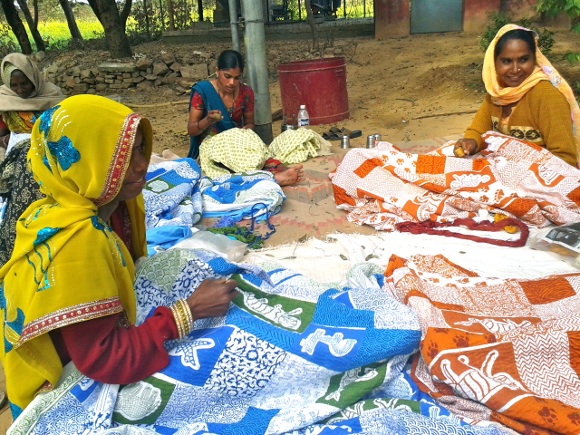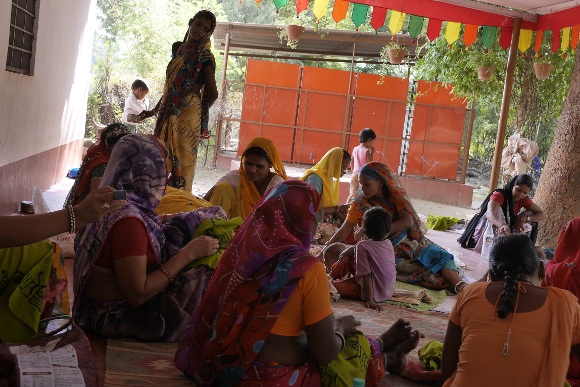Around 150 kilometres southeast of Jaipur, in the district of Sawai Madhopur is the sprawling tiger haven known as the Ranthambore National Park. When the 392 square kilometres reserve was declared a national park in 1980 under the central government's "Project Tiger" initiative, people who had been living there for centuries were relocated and barred from entering the forest area.
Till then, the forest dwellers had survived tending to their land and cattle, depending on the lush forest for sustenance. Deprived of their land and the only way of life that they ever knew, they were left clueless on how to resettle and survive.
The Ranthambhore Foundation, an Non-Government Organisation (NGO) set up to create awareness about tiger conservation and the Park's ecosystem, approached Dastkar New Delhi and formed Dastkar Ranthambhore in 1989 to help these villagers find an alternate source of living.
Padmashree Laila Tyabji, chairperson of Dastkar, headed the core project team. "The women and the village communities were hugely disillusioned and angry," she remembers. "They identified us with the government who had barred their entry into the forest for grazing their cattle and firewood collection and had not delivered on many of the promises made to them when they were resettled to create the Park. They didn’t believe anything we said. I remember one woman aggressively saying at a village meeting: First you fill my belly and the bellies of my children, then come and tell me I should do this or that…"
Explains Ujwala Jodha, chairperson, Dastkar Ranthambore, who was also with the project from inception, "The objective was to revive crafts that were specific to the area, some were on the verge of extinction. Since women here are extremely hardworking, we zeroed in on them as a workforce."
An uphill task
Tyabji had to spend weeks living with villagers in Sherpur, explaining the project to a group of six women in a tiny room.
"We had no support or credibility in terms of a local NGO who could follow up and coordinate our efforts, and the women had never worked as a group - even getting people of different castes and communities to sit in the same room together was a huge challenge. Every time we returned to New Delhi after a 4-5 day visit, everything had gone back to zero, and we had to start all over again. Hence my decision to simply move to Sherpur and live in the village for a few weeks to win understanding and trust and get the project moving," she says.
She taught them basic patchwork techniques. "As we sat and sewed together, I asked the women what they would do with their money - Some said silver jewelry, better seeds and a buffalo…The ability to send their children by bus to a fee- paying school…Medical treatment and their tubes tied at a ‘proper’ hospital…A new well in the village.. Their own bank accounts to prevent misappropriation by drunken or gambling husbands. They all wanted ‘pukka’ houses." **

Women doing embroidery and patchwork, the skills that are the backbone of Dastkar Ranthambhore. Pic: Devika Krishnan
Patchwork cushions became the first "products" to be put on sale. The team was quick to add block printing, tie and dyeing and Jutti (shoe) making to their skill set.
"The women had to learn a totally new skill as adults. Plus they had no clue about work culture - coming to work on time and so on. There were numerous hurdles," says Jodha.
Devika Krishnan, product designer and skills trainer, began working with potters from Shyamota village in 1992, when she came face to face with caste prejudices. She was told she had to travel to the outskirts of the village to meet them, where the potters were "allowed" to live. Added to this was the ugly problem of patriarchy.
"They were fine with me entertaining little children and helping the women with their chores. They let me photograph them making pots, but the men wouldn't accept a woman potter. It was unheard of," she says. She was ready to throw in the towel until Tyabji persuaded the potters to at least see Devika working. She managed to convince them and now she is considered part of their biradari or brotherhood.
"The best thing is that, today their women work alongside them," says Krishnan.
Overcoming the challenges
In 1990, Munni, who started working with Dastkar Ranthambore to help her family of 7 daughters and a son and Rameshwari, a widow with no income to take care were chosen to attend their first crafts bazaar in New Delhi.
"My husband used to earn by trading in goats, but the money was not enough to take care of my whole family. That's why I joined the project. My daughters also joined in and we were able to make a lot of money," Munni says proudly.
The two ventured out of their village for the the first time in their lives. They made Rs 65000, more money than they had ever seen. This convinced them and others in the village once they saw this more lucrative and less back breaking than the manual labour they were used to!
Dastkar Ranthambore soon received an export order for patchwork quilts. 300 more women were trained in 1997, more export enquiries followed. In 2000, a shop was set up and a government grant procured in 2003 helped them get sewing machines, a reverse osmosis plant, computers and even a basic washroom facility.

The growing community of women in Dastkar Ranthambhore. Pic: Devika Krishnan
In 2004, Dastkar Ranthambhore was registered as a Society. Reflecting the forest dwellers origins, the tiger motif was registered as its logo.
Today, Dastkar Ranthambhore produces and exports home furnishings and clothing such as cushions, quilts, table linen, bed sheets, and decorative items, apart from pottery ware, as well as shirts, dresses, kurtas, pouches, scarves, bags and pouches.
"We work with designers and have developed various collections for different markets. The embroidery and patchwork skills are the backbone of Dastkar Ranthambhore," says Jodha.
What started out with six women in a little room in Sherpur village has grown into 350 families in one centre and 70 in another, making it a total of over 800 people. They are a Rs 1 crore plus organization, with a Board comprising entirely of women.
Self-confidence is up by leaps and bounds.
"A local doctor said you could identify a Dastkar Ranthambhore woman walking on the road, just by the way she held her head. I think that says it all! Over the last 25 years, I've seen pukka houses, gas chulas, smaller families, bank accounts and savings groups, a reduction in the age girls get married, girl children being educated as well as boys, less malnutrition, a readiness to learn new skills, a sense of sharing and responsibility," says Laila Tyabji.
The changes in the society are stunning. "Methods of birth control are now canvassed along with colour combinations; old women learnt that writing their names is no more difficult than threading a needle. Wholesale dealers coming to deliver our orders now form an informal weekly market where women make purchases without an expensive trek to the town…. In the evenings, songs and stories and folklore are swapped for political gossip and revolutionary ideas of social change. The women have set up their own savings and loans micro-credit group. They are now money lenders to the whole village," Laila explains. **
Rameshwari, the young widow who travelled to New Delhi, is now the secretary and a Board member of Dastkar Ranthambhore, and has even been asked to be the Sarpanch (head) in her village. "I refused. I don't know much about Panchayats. I don't want strange men telling me what to do. Politics is dirty, and I don't want to get my hands dirty," she laughs.
Members of the original team who have aged still want to be part of the project. Kallo, who was a master embroiderer in the group, now finds herself unable to achieve the same level of perfection because of her failing eyesight. Determined to be part of the project which gave her a new lease in life, she has reinvented herself as a salesperson in one of the outlets.
Male artisans in Dastkar Ranthambhore
Prahlad, a traditional regar (tanner) and mojari (footwear) maker from Kundera, wanted to continue in his dying profession. He trained under an expert to learn the technique of chattai (weaving) which he successfully uses to make a range of footwear for urban markets. Today, Prahalad sells over a lakh worth of his goods at a bazaar.

85-year old Giriraj is the senior most artisan and an expert in Bandhni (tie dye technique). He bumped into Tyabji at a crafts fair in New Delhi when he was helping a friend. Dastkar went on to buy between 40 to 300 pomchas (stoles) a month from him, reviving a skill that had almost vanished. His children and grandchildren now keep the tradition alive.
Going forward, the organization wants to upgrade existing facilities and widen the net. "There are still crafts which are not tapped. We have to tap into that, expand our circle to include more villagers and newer crafts," says Jodha.
To celebrate their silver jubilee, Dastkar Ranthambhore had organised a 3-day Melo Ranthambore this October to celebrate their remarkable journey to self-empowerment.
Tyabji believes the project has more than fulfilled expectations. "Hope is a better word, as we didn’t expect too much initially! The only thing possibly missing is a real understanding of the importance of preserving the tiger, the ecosystem and environment, and its interrelation with the future of their children and grandchildren. This was a core of the Ranthambhore Foundation's initial objectives, but much more work needs to be done to create awareness and translate it into practice."
References
** From A Sense of Place written by Laila Tyabji























